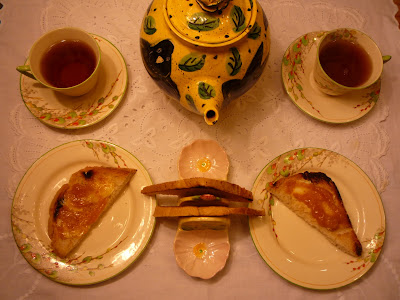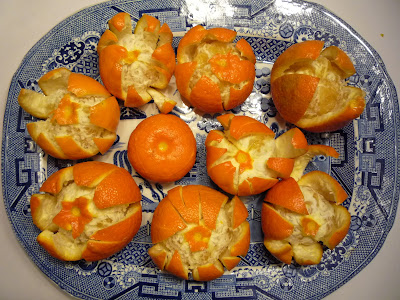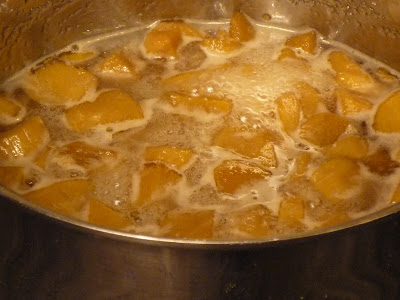Brought from the wondrous gardens of Persia, celebrated in verse and prized for their virtues in Medicine and Perfumery, the first citrus aurantium trees were planted in Spain by the Moors in the fertile land of Andalucia.
Legend has it that a ship laden with these fruit and en route from Seville was forced by storms into the safe harbour of Dundee. The captain, afraid the oranges would spoil, sold them off cheaply to a local grocer, one James Keiller, who had mistaken them for a sweet orange variety. His canny wife, substituted the bitter oranges for the usual quinces and made the traditional paste known as marmalade, (from ‘marmelo’ the Portuguese word for quince). By the end of the 18th century this new sweetmeat had become so popular that the Keiller family had established a factory making the breakfast preserve still known as ‘Dundee Seville Orange Marmalade’.
To make a manageable batch of marmalade, I use 3 kilos (just over 6½lbs) of citrus fruit (with a majority of Seville Oranges) plus half their weight in raw cane sugar. As this preserve contains only one third sugar and traditional marmalades are half sugar, I jar some for use and freeze the rest in reasonable quantities to boil up and jar as needed.
My recipe is made of a mixture of citrus fruits including pink grapefruit as well as the traditional Seville bitter oranges. I always like to minimise the sugar to fruit ratio in my preserves. Organic sugar by weight is much sweeter than the non organic kind and tempering its content, lessens the risk of overpowering the bitter sweetness of the fruit. Marmalade is traditionally seasonal, made for a very limited period in the Winter months, when Seville oranges ripen. It is also eminently suitable as an organic recipe as its unique taste comes in part from the peels of the fruit which in organic agriculture are untreated and unwaxed.
Begin by washing the fruit to remove any dust. Remove peel. My marmalade recipe initially requires the peel and pulp to be dealt with separately. I've found this makes the peel more digestible.
I employ a method for preparing the peels, which I found in a family copy of Mrs. Beeton's Household Management from 1861. This removes the bitterness without impairing the taste. Start by adding all the peels to a saucepan, cover with cold water, put on lid and bring to the boil. As soon as you have a rolling boil, remove from heat, drain and rinse. Repeat this process three times in total. Then taking a sharp knife, remove as much pith as possible from the peel, which is then cut into strips. This is the same cooking method I use for making candied peel and can be found here: http://simplyorganicrecipes.blogspot.fr/2013/02/how-to-make-organic-candied-citrus-peels.html
Concurrently, chop the bitter oranges into small pieces and remove as many pips as possible. Place all the fruit pulp in another saucepan, add sugar and stir over gentle heat until dissolved.
 You can now add the peel, cover the pan and heat gently. After about an hour and a half the fruit should be well enough cooked to be liquidised.
You can now add the peel, cover the pan and heat gently. After about an hour and a half the fruit should be well enough cooked to be liquidised. I have a wood cooker so I leave mine for a couple of hours on the side of the cooker top just off the hot plate. Mrs. Beeton suggests that the longer marmalade cooks the better the flavour.
GARDENING TIP
Ginger is quite easy to grow in the house or greenhouse. Chinese ginger seems the best for colder climates. I bought a root at our local organic shop and left it out in the kitchen until a bud appeared. I then suspended the root in water, with the bud partly submerged. Within a few days roots appeared and I then transferred it to a planter filled with a soil and compost mix.
Add a good handful of the crystallised ginger and at the same time test for flavour and if needed add a little of the excess sugar left from crystallising the ginger. Stir well to incorporate the ginger and then heat to a rolling boil. It's so easy to make the above, so here's the link showing the simple method by which I crystallise the ginger root. http://simplyorganicrecipes.blogspot.fr/2013/02/how-to-crystallise-organic-ginger-root.html
After a few minutes further cooking you can test to see if the marmalade will set by putting a small amount on a cold saucer. Leave it to cool for a few seconds and then lightly skin the surface of the marmalade with the side of your little finger. If the surface wrinkles against your finger the preserve is ready. Prepare some glass jars by sterilising them in boiling water and leaving them to dry and remain hot in the oven. The finished marmalade can then be poured into them. I usually only jar up two lots of marmalade and freeze the rest. If you do not wish to freeze you will have to add more sugar to the mix, normally the same weight as the fruit, or alternatively, make smaller quantities, otherwise you run the risk of the marmalade not keeping.
-----------------------------------------------------------------------------------------------
One of the first vitamins to be depleted by stress is vitamin C. I didn't know this until I observed the behaviour of one of my bantam cockerels, recovering from cold stress. I could not help noticing, that of all the foodstuffs I had provided to help him combat it, he always chose the citrus first. I then googled it!
-----------------------------------------------------------------------------------------------
Or if you'd rather, just sit back and watch some dancing fruit:-
If you've enjoyed this post, please feel free to share it and/or comment or ask questions.
I'll wish you bon appétit and hope to see you next time, Sue
Return to 'WHAT'S ON THE MENU' for more Simply Organic Recipes
© 2013 Sue Cross

















